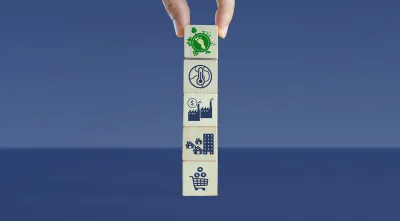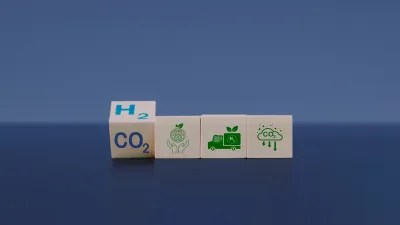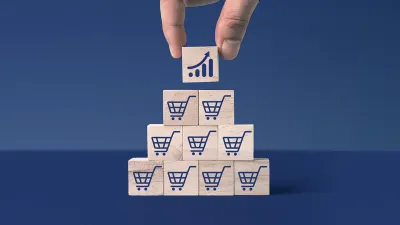Industry and Other Businesses
Waste management costs can form a significant part of a company's expenses in the industry and businesses. Saving waste management costs offers an economic advantage and supports environmentally friendly and sustainable operations.

Saving on Waste Management Costs in Industry and Businesses – Eco-efficiency and Better Results.
Problem
Waste management costs are caused by overburdened waste collection tools requiring more frequent emptying and causing environmental harm. In contrast, underutilized waste collection tools are not cost-effective as their emptying interval is not optimized.
Solution
The sizing of waste collection tools should align with actual waste amounts. Too small bins can cause overflows, odor nuisances, and additional costs, whereas too large containers may remain only partially filled, leading to extra transports and increasing CO2 emissions.
Predictive assessment of the waste quantity and careful planning of the size and location of waste bins are critical factors in achieving optimal waste management. For example, the emptying interval can be shortened to increase capacity, or the number of containers can be improved.
Regular monitoring helps maintain the efficiency and environmental friendliness of waste management.
As a result of optimization
- Selection and optimal sizing of waste collection tools save costs
- Predictive assessment of waste quantity improves efficiency
- Careful planning reduces CO2 emissions
- Recycling of waste brings additional income
Problem
Suboptimal placement of waste collection tools and limited space increase waste management costs as they complicate emptying and transport, leading to increased time and fuel consumption.
Solution
If space is scarce, the possibility of using more compact or differently shaped waste collection tools that better suit limited areas can be explored.
Making a detailed plan, optimizing the locations, and utilizing new technologies and intelligent solutions to improve placement are advisable. The program can include, for example, clear signs and markings in the area so that the order of waste collection tools is easy and logical.
In addition, the need to change the locations of waste collection tools can be assessed so that emptying and transport run smoothly. Furthermore, the waste management company can decide on the model of the waste truck to be used and how often waste emptying should be arranged.
Monitoring also helps ensure that waste collection tool placement is optimal and efficient.
As a result of optimization
- Utilization of more compact and differently shaped waste collection tools saves space
- A detailed plan enables better placement of waste collection tools
- Smart solutions and new technologies enhance the use of waste collection tools
- Optimal emptying times and choice of waste truck reduce costs
- Changing the location of waste collection tools facilitates and speeds up emptying and transport
Problem
Mixing waste collection materials causes costs in waste management because it hinders the proper recycling and processing of materials.
Solution
A problem in waste management is the challenges in recycling, which can occur, for example, in the sorting of waste materials or the efficiency of the recycling process. It is essential to ensure that waste materials are properly sorted and that recycling is as efficient as possible.
Good signs and instructions for waste collection tools help prevent mixing waste collection materials. Using colors in the interiors of waste collection tools for different materials facilitates sorting and reduces mixing. One solution to avoid mixing materials in a waste collection tool is to implement a clear and straightforward collection order, which guides the materials naturally to the correct collection points. In addition, clear instructions for users help ensure that the waste in the waste collection tool is sorted correctly.
Solving the challenges of sorting and recycling improves environmental impacts and lowers waste management costs in the long run.
As a result of optimization
- Clear signs and instructions improve sorting
- Color-coded interiors of waste collection tools facilitate identifying and collecting different materials
- Introduction of a simple sorting system reduces mixing
- Properly sorted waste lowers recycling costs
- Better sorting and recycling increase opportunities for reus
Problem
Bio-waste management requires specialized sorting and transport, which can increase waste management costs. This is particularly challenging in small municipalities and rural areas where long transport distances make directing waste to treatment more complex.
Solution
Solutions to these challenges can be found by developing new and cost-effective methods for collecting, transporting, and processing bio-waste. New technologies can also enhance the utilization of bio-waste. Examples include increasing biogas production and improving the composting process in bio-waste treatment.
In addition, not all bio-waste is necessarily directly “just waste.” Still, when properly treated, it can serve as a raw material that can be used as is or processed for animal feed.
As a result of optimization
- Cost-effective methods for collecting and transporting bio-waste
- Utilization of new technologies in bio-waste treatment
- Increase in biogas production and enhancement of composting process
- Processing of bio-waste
- Utilization of surplus materials
- Savings in waste management costs and new sources of income through the reuse of bio-waste
Problem
The challenges in waste management related to the collection of plant-based oils often stem from their complexity and the difficulty of separate compilation. The collection process may be tricky and messy, as the hot and liquid oil is challenging to collect.
Solution
One solution to the challenges of collecting plant-based oils in waste management is implementing closed collection systems designed to treat these wastes. Plant-based oil is managed separately from other waste in these systems for reuse.
In addition, reusing plant-based oils is one way to reduce the environmental harm caused by their use and to conserve natural resources.
As a result of optimization
- Guiding towards the use of closed collection systems for plant-based oils
- Waste management that reduces environmental risks
- Increasing reuse



